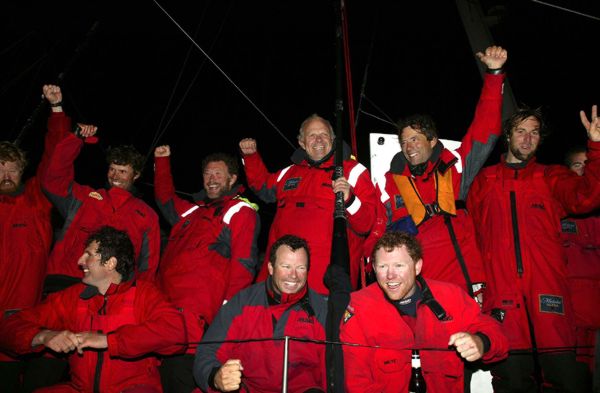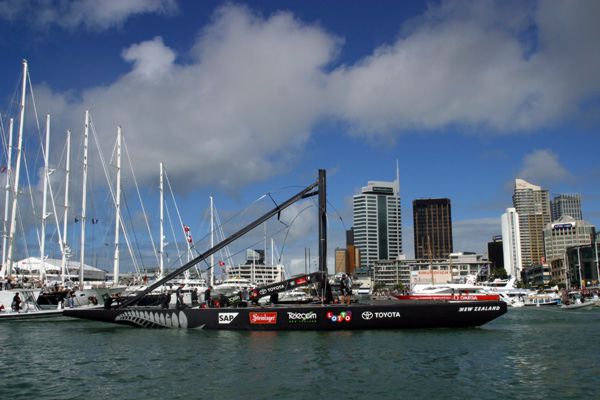Advertisement
Advertisement
ENZA New Zealand Sets Circumnavigation Record
Around the world in 74 days; January 16 to April 1, 1994
December 5, 2001
ENZA New Zealand, the 92-foot catamaran co-skippered by Peter Blake and Robin Knox-Johnston returned to Ushant on April 1, 1994 riding the tale end of a 50-knot southwesterly gale to slash more than four days off the non-stop circumnavigation record.
The sight of Creac'h lighthouse marking the dangerous rocky outcrop off the Brittany coast was the first land this eight-man crew had seen since they had set out on the 27,000-mile record attempt in a gale of similar strength on January 16. After trailing warps and an anchor chain behind them in an effort to keep speed below 10 knots and to avoid pitch-poling its multihull in the huge seas, Knox-Johnston said on arrival, "The last 36 hours have been the worst conditions we have experienced during the entire voyage. Now I'm looking forward to a good pint of Guinness."
Knox-Johnston, who took 313 days to complete the same voyage solo in 1966, did it this time in 74 days 22 hours and 17 minutes to become one of only three men to have twice circumnavigated the globe non-stop. He and his fellow ENZA
crew broke the record best time set in 1993 by Bruno Peyron's 85-foot catamaran Commodore Explorer by 4 days 7 hours 58 minutes to claim the Jules Verne trophy.
Peyron was one of the first to welcome the crew on its return to Brest. "It's a fantastic feat and I'm glad it is a foreign challenge that has broken the record. This will do more to publicize the sport than any Frenchman could have achieved and will make everyone sit up at home."
The voyage was not without its dramas. Blake badly injured his back when the boat nose-dived into a wave deep in the Southern Ocean. The injury confined Blake to his bunk for two weeks and the crew came close to calling the challenge off. "That frightened us," admitted Knox-Johnston.
Later, they were forced to head down to 61 South in the Pacific Ocean to avoid a high pressure system sitting uncharacteristically over the Roaring Forty and Furious Fifty latitudes. Crewman Ed Danby recalled, "We had ice all around us and passed between two growlers — one half a boat length to one side with little more dividing us from the other. After that, we had someone stationed on the bows every night to give us a little extra warning."
The crew lost a further five days battling against storm-force head winds south of Cape Horn, but Blake agreed with his co-skipper that conditions at the finish had been the worst. "We were experiencing 60-knot squalls and very big seas, some as high as 50 feet. I was very concerned about nose-diving again. We did so the other night and Angus Buchanan shot out of his bunk and ended up in the galley. That forced us to be prudent, and after that we sailed either under bare poles or with a small jib set, dragging lines behind us to keep the speed down."
The ENZA New Zealand had set out from Brest at the same time as Lyonnaise des Eaux-Dumez, a 90-foot French trimaran skippered by Olivier de Kersauson. The ENZA averaged more than 400 miles a day for the first 16,000 miles of the voyage. Making a record run of 520.9 miles during one memorable 24-hours, ENZA had built up a 1,500 mile lead by the time it had passed south of New Zealand, but it lost much of the lead during the diversion south. After being stalled again at Cape Horn, de Kersauson's crew rounded little more than a day astern and later crossed the Equator almost level. ENZA, however, was better placed to make most of the trade winds and after what Knox-Johnston called "double dose of the Doldrums and Azores High," and finished two days ahead of its rival.
This was Blake's fifth circumnavigation and his second attempt with Knox-Johnston to win the Jules Verne Trophy. Last winter they were leading the race when ENZA (then measuring 85 feet) hit an unknown object and was holed in the Indian Ocean after 26 days at sea. The 45-year-old yachtsman said, "It's been a fabulous experience. This has been much more than just yachting. It has been a real adventure. All the way 'round we were talking about a new boat. With a bigger boat and a bit of luck perhaps, you could get 'round the world in 67 days — but it won't be me!"
The Boat
ENZA New Zealand is the former 85-foot Nigel Irens-designed Formula TAG, which Canadian Mike Birch campaigned during the 1980s. Built in Montreal by Canadair, it was one of the first craft to be molded almost exclusively of carbon fiber. After its ill-fated Jules Verne attempt in 1993, it was shipped to New Zealand where an outer skin was molded over the underwater sections of the hulls to improved its
shape and provide an extra margin of safety.
The boat was also fitted with a central nacelle — or God-Pod as the crew called it — to afford greater protection and a central area to eat, sleep and navigate. This was fitted for the first Jules Verne attempt, but the bottom took such a pounding the second time around that the crew had to repair it with high-density foam reinforced with layers of glass fiber. This was the only structural damage sustained.
ENZA was also equipped with a carbon fiber mast built by Carbospars. It is the same section as that fitted to the Swan 77 but, apart from changing the cap-shrouds after the first aborted challenge, it completed the second attempt with its original rigging — covering some 40,000 miles!
The Crew
Co-skippers: Peter Blake (NZL) & Robin Knox-Johnston (GBR)
Crew: David Alan-Williams (GBR); Angus Buchanan (GBR); Ed Danby (NZL); George Johns (GBR); Barry McKay (NZL); Don Wright (NZL)
The Records
Record Circumnavigation: 74 days: 22 hours: 17 minutes: 22 seconds
Ushant to Equator: 7 days: 4 hours: 24 minutes (1:15:2 faster than Commodore)
Ushant to Cape of Good Hope: 19:17:53 (1:18:54 faster than Commodore)
Ushant to Cape Leeuwin (Australia): 29:16:1 (3:15:46 faster than Commodore)
Ushant to Cape Horn: 48:2:32 (5:4:10 faster than Commodore)
Equator to Cape of Good Hope: 12:13:29 (3 hours: 52 minutes faster than Commodore)
Cape of Good Hope to Cape Leeuwin: 9:22:8 (1:20:51 faster than Commodore)
Advertisement
Advertisement












